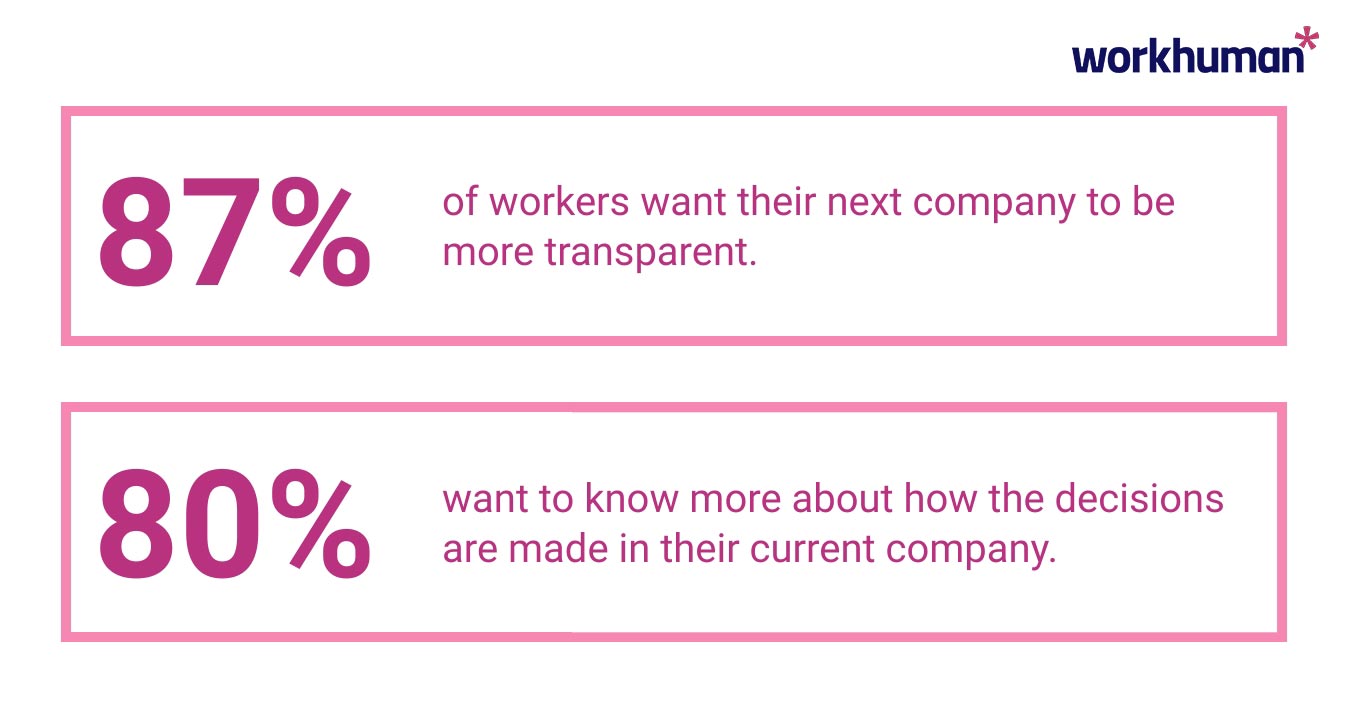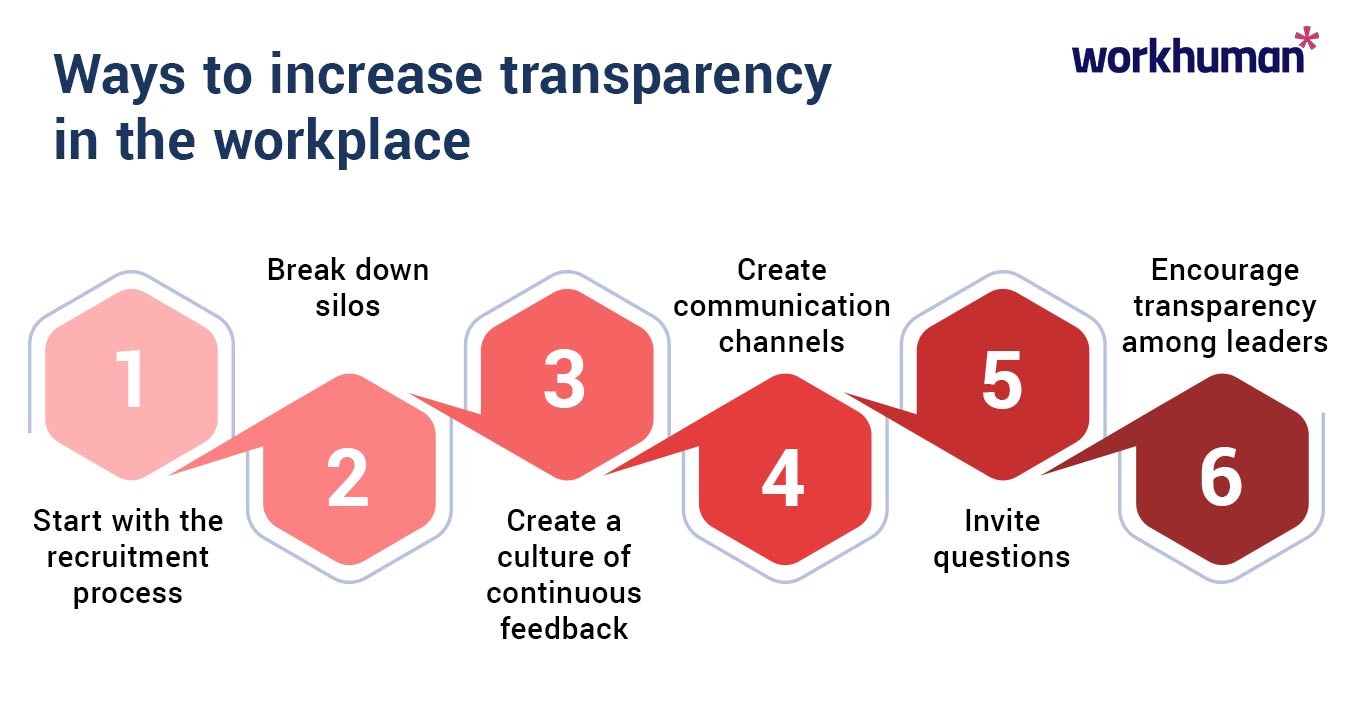Transparency in the Workplace: How to Overcome Common Barriers

Transparency in the workplace – a company culture that promotes openness and information sharing throughout – has historically been viewed as more risky than rewarding. Recently, there's been a cultural shift, and companies have started to embrace honesty to keep up with competitors and retain talent.
Despite efforts to provide more transparency in the past few years, recent research from "Future Forum" shows a huge disconnect between what executives think is happening and how employees actually feel. 73% of executives believe they are being "very transparent" while only 41% of employees agree.
It can be challenging to pinpoint where your company might be going wrong. Read on to identify these barriers and create a more transparent workplace culture.
Why is workplace transparency important?
Workplace transparency is key to building trust, and building trust in the workplace helps to foster mutual respect between employer and employee. A respectful work environment helps uphold accountability on both ends.
Beyond that, employees want to know what's happening behind the scenes. 87% of workers want their next company to be more transparentOpens in a new tab, and 80% want to know more about how the decisions are made in their current company. Knowing what is going on helps to keep employees invested in their work and how it relates to the company's overall success.

Engaged employees are crucial when building a company culture. A positive culture leads to higher productivity, happier customers, and increased retention. In other words, transparency isn't just good for your employees, it's also good for business. Why is trust important in leadership? It shouldn't be a hard sell to leadership since it costs nothing to implement.
You might also like: 20 words to describe company culture
Benefits of workplace transparency
Beyond making employees feel happier, more involved, and less likely to have one foot out the door, there are other positive side effects of having an open and transparent company culture. You'll likely notice the following benefits:
- Transparency improves teamwork and strengthens social connections throughout the organization. It's easier to make connections and meet other people. There'll be a decrease in secrecy, rumors, and gossip.
- A transparent culture helps to reveal great ideas. When everyone knows what's going, and feels psychologically safe enough to speak up, employees will feel free to share information and a result, innovation will come from all directions in the organization.
Download our exclusive report on how to build psychological safety.
- Your company will see an increase in productivity and efficiency. This happens because people are in the loop. When employees know what's going on, they feel an increased sense of autonomy and can make quick decisions.
- Your workforce will feel more satisfied in their roles. In fact, employees who perceive their companies to be transparent have 8.8 times higher job satisfaction than employees who don't feel that their company is transparent.
- A transparent culture can also help with diversity efforts. When more information is shared, it increases the chances inequities will be revealed and resolved.
What a lack of transparency at work looks like
A lack of transparency will seep into all aspects of your company. Beyond surveying employees to understand how your efforts are faring, keep an eye out for these symptoms:
- Low employee engagement
- Lack of employee input
- Competitive, siloed, and secretive workplace culture
- Increased turnover
- Low employee trust
- Decreased employee satisfaction
- Leadership lacks a voice
What are the barriers to workplace transparency?
If your company has increased your transparency efforts but are not experiencing as many positive changes to your culture as you'd like, try to overcome the below barriers that can prevent your efforts from making an impact.
- The biggest barrier to a truly transparent company is leadership. A leader's openness – or lack of – sets a precedent for the entire organization. Managers and employees will only feel comfortable being vulnerable and honest if leadership sets the tone.
- Another way your company will be held back is with a lack of tools and technology. Transparency boils down to communication. In a work-from-anywhere world, companies must have collaboration tools for remote teams so leadership can connect with employees and employees can communicate with each other.
- A siloed organization can hinder organizational transparency as well. If teams and departments are hesitant to share information with each other because it's not a common or encouraged practice, there will be less connection between teams.
Ways to increase transparency in the workplace
Although your company can choose to make transparency a core value, achieving workplace transparency doesn't happen overnight, and must continuously be practiced. Use the advice below to improve transparency in your workplace today.

Start with the recruitment process
There's ample opportunity to be transparent throughout the hiring process. Providing pay transparency, like sharing a salary range, in a job posting is one way to start. Your company can also share data on how the company is doing with sustainability and diversity efforts.
During the interview process, be frank about the company's performance and challenges. Be upfront about what the company is hoping to achieve by filling the role and be honest about why the role is open.
Pulling the wool over a candidate's eyes to close an open role isn't worth it. If you mislead or misrepresent the role, the candidate is likely to have a poor experience, leave, and you'll be back at square one.
And a built-in benefit of building a culture of transparency: being known as a transparent company can help your brand reputation, helping to attract top talent.
Break down silos
Encourage employees to be open with other teams to minimize competition and create a friendly, happy-to-help culture. To do this, create company-wide or joint-department goals that teams can strive towards together. These goals will spark joint-department meetings and transparent communication throughout the organization.
Create a culture of continuous feedback
Open up avenues for continuous feedback to flow between leaders, managers, and employees. Consider using a feedback platform like Workhuman®'s Conversations® to give all employees the opportunity to request and receive constructive feedback from anyone up and down the org chart.
Employees need more than a yearly performance review and research backs up the impact frequent feedback can have – companies that provide regular feedback have a 14.9% lower turnover risk.
See how ditching annual reviews and adopting a more human-centric approach improves employee engagement and reduces turnover.
Create communication channels
Set your company up for success by creating ways for employees to connect. Technology is a vital tool in supporting the strength and connection of your asynchronous and hybrid work teams – make sure your company is using it to your advantage.
Invest in the proper technology and have your IT teams keep an eye on any new technologies that could close gaps in your company's communication channels. For example, if a team is looking to crowdsource creative ideas throughout the company, ensure that employees have access to, and know how to use, a brainstorming tool.
Besides using technology to help get work done more efficiently, ensure that employees have messaging tools to connect over shared interests or hobbies outside of work like movies, cooking, and sports.
Invite questions
Dialogue about your business should not be a one-way street. Collect feedback and questions from employees and take the time to thoughtfully respond to queries. It's important to ensure that employees have the option to remain anonymous when sharing their thoughts.
Host company-wide meetings or regularly share responses via other communication channels that address concerns so employees know that their voices are being heard.
Encourage transparency among leaders
As discussed, leaders must take the first step in creating a transparent work environment. Transparency requires buy-in from leadership for it to work. A leader committed to being transparent might not shy away from open communication even when sharing difficult news, ask for feedback and opinions, and practice consistency.
FAQs
How do you show transparency in the workplace?
Transparency can be modeled in the workplace by all employees but the greatest impact will come from the top down. Leaders, be open and honest about performance, goals, and setbacks. Managers can follow their lead and offer consistent feedback. And employees at all levels can promote transparency by sharing information with colleagues.
Why is transparency important for employees?
In short, transparency is important for employees because it helps them feel connected to their work, their colleagues, and their company. Transparency builds trust between employer and employee and increases the chances that a worker will be engaged and less likely to move on.
Conclusion
As we've learned, transparency in the workplace doesn't just improve the employee experience, it also improves business. But despite making strides to be more open, your company might face setbacks like a lack of leadership, inefficient technology, and a siloed culture.
To help get past these barriers invest in technology, invite and share feedback, and encourage leaders to commit to consistency. Now that you're armed with this advice and information, what will you do today to improve your workplace's transparency efforts?
About the author
Alicyn Zall
Alicyn Zall is a writer dedicated to creating a more equitable and fulfilling workplace. With a focus on actionable, data-driven insights, her work empowers individuals and organizations to foster positive change. In addition to her contribution at Workhuman, Alicyn has served as an editor at Harvard Business Review where she developed books and articles about mental health and the future of work.